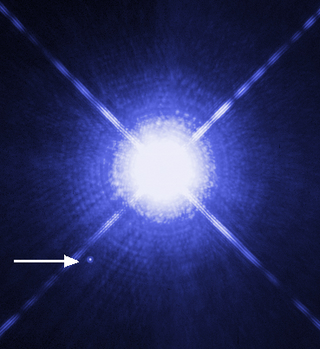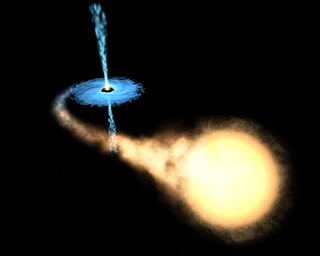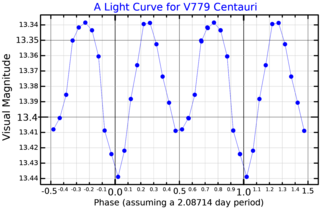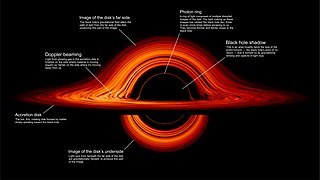
A neutron star is the collapsed core of a massive supergiant star, which had a total mass of between 10 and 25 solar masses (M☉), possibly more if the star was especially metal-rich. Except for black holes, neutron stars are the smallest and densest known class of stellar objects. Neutron stars have a radius on the order of 10 kilometers (6 mi) and a mass of about 1.4 M☉. They result from the supernova explosion of a massive star, combined with gravitational collapse, that compresses the core past white dwarf star density to that of atomic nuclei.

Stellar evolution is the process by which a star changes over the course of time. Depending on the mass of the star, its lifetime can range from a few million years for the most massive to trillions of years for the least massive, which is considerably longer than the current age of the universe. The table shows the lifetimes of stars as a function of their masses. All stars are formed from collapsing clouds of gas and dust, often called nebulae or molecular clouds. Over the course of millions of years, these protostars settle down into a state of equilibrium, becoming what is known as a main-sequence star.

A white dwarf is a stellar core remnant composed mostly of electron-degenerate matter. A white dwarf is very dense: its mass is comparable to the Sun's, while its volume is comparable to Earth's. A white dwarf's low luminosity comes from the emission of residual thermal energy; no fusion takes place in a white dwarf. The nearest known white dwarf is Sirius B, at 8.6 light years, the smaller component of the Sirius binary star. There are currently thought to be eight white dwarfs among the hundred star systems nearest the Sun. The unusual faintness of white dwarfs was first recognized in 1910. The name white dwarf was coined by Willem Luyten in 1922.

A variable star is a star whose brightness as seen from Earth changes with time. This variation may be caused by a change in emitted light or by something partly blocking the light, so variable stars are classified as either:

Cygnus X-1 (abbreviated Cyg X-1) is a galactic X-ray source in the constellation Cygnus and was the first such source widely accepted to be a black hole. It was discovered in 1971 during a rocket flight and is one of the strongest X-ray sources detectable from Earth, producing a peak X-ray flux density of 2.3×10−23 W/(m2⋅Hz) (2.3×103 jansky). It remains among the most studied astronomical objects in its class. The compact object is now estimated to have a mass about 21.2 times the mass of the Sun and has been shown to be too small to be any known kind of normal star or other likely object besides a black hole. If so, the radius of its event horizon has 300 km "as upper bound to the linear dimension of the source region" of occasional X-ray bursts lasting only for about 1 ms.

X-ray binaries are a class of binary stars that are luminous in X-rays. The X-rays are produced by matter falling from one component, called the donor, to the other component, called the accretor, which is either a neutron star or black hole. The infalling matter releases gravitational potential energy, up to 30 percent of its rest mass, as X-rays. The lifetime and the mass-transfer rate in an X-ray binary depends on the evolutionary status of the donor star, the mass ratio between the stellar components, and their orbital separation.
The Eddington luminosity, also referred to as the Eddington limit, is the maximum luminosity a body can achieve when there is balance between the force of radiation acting outward and the gravitational force acting inward. The state of balance is called hydrostatic equilibrium. When a star exceeds the Eddington luminosity, it will initiate a very intense radiation-driven stellar wind from its outer layers. Since most massive stars have luminosities far below the Eddington luminosity, their winds are mostly driven by the less intense line absorption. The Eddington limit is invoked to explain the observed luminosity of accreting black holes such as quasars.
Soft X-ray transients (SXTs), also known as X-ray novae and black hole X-ray transients, are composed of a compact object and some type of "normal", low-mass star. These objects show dramatic changes in their X-ray emission, probably produced by variable transfer of mass from the normal star to the compact object, a process called accretion. In effect the compact object "gobbles up" the normal star, and the X-ray emission can provide the best view of how this process occurs. The "soft" name arises because in many cases there is strong soft X-ray emission from an accretion disk close to the compact object, although there are exceptions which are quite hard.
X-ray pulsars or accretion-powered pulsars are a class of astronomical objects that are X-ray sources displaying strict periodic variations in X-ray intensity. The X-ray periods range from as little as a fraction of a second to as much as several minutes.

Centaurus X-3 is an X-ray pulsar with a period of 4.84 seconds. It was the first X-ray pulsar to be discovered, and the third X-ray source to be discovered in the constellation Centaurus. The system consists of a neutron star orbiting a massive, O-type supergiant star dubbed Krzeminski's star after its discoverer, Wojciech Krzemiński. Matter is being accreted from the star onto the neutron star, resulting in X-ray emission.
Scorpius X-1 is an X-ray source located roughly 9000 light years away in the constellation Scorpius. Scorpius X-1 was the first extrasolar X-ray source discovered, and, aside from the Sun, it is the strongest apparent non-transient source of X-rays in the sky. The X-ray flux varies day-to-day, and is associated with an optically visible star, V818 Scorpii, that has an apparent magnitude which fluctuates between 12-13.

A Type Ia supernova is a type of supernova that occurs in binary systems in which one of the stars is a white dwarf. The other star can be anything from a giant star to an even smaller white dwarf.

An ultraluminous X-ray source (ULX) is an astronomical source of X-rays that is less luminous than an active galactic nucleus but is more consistently luminous than any known stellar process (over 1039 erg/s, or 1032 watts), assuming that it radiates isotropically (the same in all directions). Typically there is about one ULX per galaxy in galaxies which host them, but some galaxies contain many. The Milky Way has not been shown to contain a ULX, although SS 433 may be a possible source. The main interest in ULXs stems from their luminosity exceeding the Eddington luminosity of neutron stars and even stellar black holes. It is not known what powers ULXs; models include beamed emission of stellar mass objects, accreting intermediate-mass black holes, and super-Eddington emission.

The rp-process consists of consecutive proton captures onto seed nuclei to produce heavier elements. It is a nucleosynthesis process and, along with the s-process and the r-process, may be responsible for the generation of many of the heavy elements present in the universe. However, it is notably different from the other processes mentioned in that it occurs on the proton-rich side of stability as opposed to on the neutron-rich side of stability. The end point of the rp-process is not yet well established, but recent research has indicated that in neutron stars it cannot progress beyond tellurium. The rp-process is inhibited by alpha decay, which puts an upper limit on the end point at 104Te, the lightest observed alpha-decaying nuclide, and the proton drip line in light antimony isotopes. At this point, further proton captures result in prompt proton emission or alpha emission, and thus the proton flux is consumed without yielding heavier elements; this end process is known as the tin–antimony–tellurium cycle.
In X-ray astronomy, quasi-periodic oscillation (QPO) is the manner in which the X-ray light from an astronomical object flickers about certain frequencies. In these situations, the X-rays are emitted near the inner edge of an accretion disk in which gas swirls onto a compact object such as a white dwarf, neutron star, or black hole.

Gamma-ray burst progenitors are the types of celestial objects that can emit gamma-ray bursts (GRBs). GRBs show an extraordinary degree of diversity. They can last anywhere from a fraction of a second to many minutes. Bursts could have a single profile or oscillate wildly up and down in intensity, and their spectra are highly variable unlike other objects in space. The near complete lack of observational constraint led to a profusion of theories, including evaporating black holes, magnetic flares on white dwarfs, accretion of matter onto neutron stars, antimatter accretion, supernovae, hypernovae, and rapid extraction of rotational energy from supermassive black holes, among others.
An AM Canum Venaticorum star, is a rare type of cataclysmic variable star named after their type star, AM Canum Venaticorum. In these hot blue binary variables, a white dwarf accretes hydrogen-poor matter from a compact companion star.
A luminous supersoft X-ray source is an astronomical source that emits only low energy X-rays. Soft X-rays have energies in the 0.09 to 2.5 keV range, whereas hard X-rays are in the 1–20 keV range. SSSs emit few or no photons with energies above 1 keV, and most have effective temperature below 100 eV. This means that the radiation they emit is highly ionizing and is readily absorbed by the interstellar medium. Most SSSs within our own galaxy are hidden by interstellar absorption in the galactic disk. They are readily evident in external galaxies, with ~10 found in the Magellanic Clouds and at least 15 seen in M31.

Astrophysical X-ray sources are astronomical objects with physical properties which result in the emission of X-rays.

An accretion disk is a structure formed by diffuse material in orbital motion around a massive central body. The central body is most frequently a star. Friction, uneven irradiance, magnetohydrodynamic effects, and other forces induce instabilities causing orbiting material in the disk to spiral inward toward the central body. Gravitational and frictional forces compress and raise the temperature of the material, causing the emission of electromagnetic radiation. The frequency range of that radiation depends on the central object's mass. Accretion disks of young stars and protostars radiate in the infrared; those around neutron stars and black holes in the X-ray part of the spectrum. The study of oscillation modes in accretion disks is referred to as diskoseismology.













